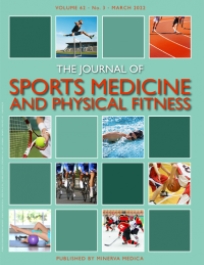Sanchis-Gomar F1, Alis R2,3, Rampinini E4, Bosio A4, Romagnoli M1,5, Lombardi G6, Lippi G7
1, Research Institute “Dr. Viña Giner”, Molecular and Mitochondrial Medicine; 2, Research Institute “Dr. Viña Giner”, Molecular and Mitochondrial Medicine, Catholic University of Valencia San Vicente Mártir, Valencia, Spain; 3, School of Medicine, Catholic University of Valencia San Vicente Mártir, Valencia, Spain; 4, Human Performance Laboratory, MAPEI Sport Research Center, Olgiate Olona, Italy; 5, Department of Physical Education and Sports, University of Valencia, Valencia, Spain; 6, Laboratory of Experimental Biochemistry & Molecular Biology, I.R.C.C.S. Istituto Ortopedico Galeazzi, Milano, Italy; 7, Laboratory of Clinical Chemistry and Hematology, Academic Hospital of Parma, Parma, Italy

AIM: Recent evidence has showed that serum or salivary values of α-amylase predict endurance running performance. In this study we investigate whether serum α-amylase concentration may be associated with training status during a competitive season and after a detraining period in professional soccer players. METHODS: The study population consisted in 15 male professional soccer players from an Italian major league team (age (mean±SD) 27±5 years, weight 76.9±4.1 kg, height 1.82±0.05 m). Serum α-amylase levels were measured 3 times during the last part of a competitive season (January, March and May) and just before preseason training (July). RESULTS: Metabolic and cardiovascular fitness of soccer players was improved during the last part of the season. The levels of α-amylase did not change significantly throughout the study period (χ2 = 7.331, p = 0.062), nor they were found to be associated with variation of physical fitness and training status. CONCLUSION: The α-amylase fluctuations throughout a competitive season and after vacation time were meaningless in professional soccer players. No significant associations with physical fitness variations could be observed. These results suggest that α-amylase concentration may be a useful parameter for identifying individual inclination to endurance exercise, but not for predicting actual training status.
J Sports Med Phys Fitness. 2015 Dec 1. PMID: 26630173 DOI: 10.23736/S0022-4707.16.06001-1